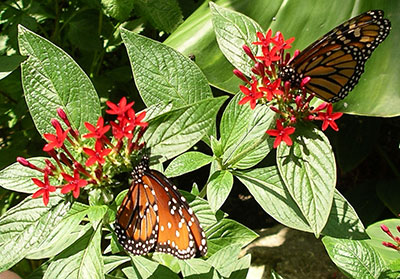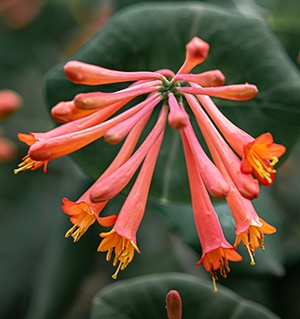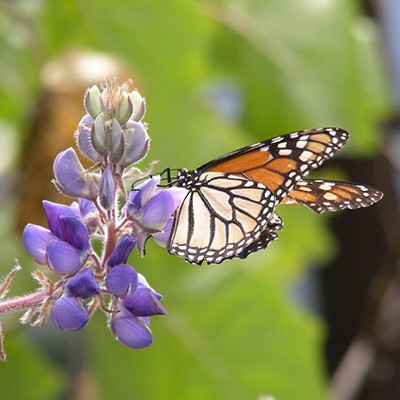Gardening for Butterflies
Florida has over 200 species of butterflies, some of which cannot be found anywhere else on Earth.

To attract these delicate creatures, your butterfly garden must provide food for both the adult butterflies and their caterpillars. Though many butterflies will drink nectar from a variety of flowering plants, their caterpillars are often limited as to which plants they can feed on.
Major Components of a Successful Butterfly Garden
- Adult nectar sources: attract and nourish adult butterflies.
- Larval host plants: attract ovipositing female butterflies, serve as a food source for developing larvae.
- Shelter: vegetation that provides protection from temperature extremes, storms/rain, and predators as well as locations for roosting/sleeping.
- Water source with fountain: allows for easy and consistent access to water for drinking and thermoregulation.
Garden Design
A wide assortment of flowers is better than having just a few kinds. Butterflies are attracted to brightly colored, simple flowers with good places to perch. To make sure that nectar is always available, choose your flowers so that something is always in bloom.

- Provide a combination of adult nectar sources and larval host plants: attracts maximum variety of butterfly species; encourages butterflies to remain in your yard, reproduce, and build populations instead of just passing through; allows gardener to appreciate all life stages.
- Incorporate native plants into the landscape whenever possible: most larval host plants are natives. They’re adapted to the region, will produce a small but representative extension of the natural ecosystem, and can attract other wildlife.
- Create horizontal and vertical heterogeneity: choosing plants that have different heights and growth habits creates numerous microclimates which in turn appeal to a greater number of butterfly species; provides shelter; creates levels/strata of feeding opportunities.
- Aim for a consistent host plant and floral venue throughout the growing season: choose plants that have different blooming times; ensures that garden remains attractive and productive as long as possible; provides food for butterflies during periods of low natural availability.
- Provide a number of different flower colors: different butterfly species are attracted to different flower colors so include yellow, orange, white, and blue flowers as well as reds, pinks, and purples.
- Provide a mix of flower shapes: the feeding behavior and proboscis length of a butterfly dictate which flowers will be visited: long-tubed flowers, for example are typically more accessible to species with long a proboscis whereas many composites (daisy-like flowers) provide a feeding platform and easy nectar accessibility for smaller species.
- Plant in shade as well as full sun: appeals to more butterfly species; many forest species prefer shadier locations.
- Plant in groupings: are aesthetically pleasing; provide masses of color; are more apparent in landscape; allow larvae to locate additional food resources in event of shortage.
- Choose appropriate plants for each location: understand each plan’s basic water, light, and soil requirements so it will perform and grow to its maximum potential.
Garden Maintenance
Select plants that are suitable for your landscape, and use pesticides carefully to avoid harming your butterfly guests and other beneficial insects.
- Give new plants a good start: water and mulch new plantings to ensure firm establishment.
- Fertilize: a regular fertilizing regimen will produce maximum growth and flower production.
- Avoid pesticide application when possible: all butterfly life history stages are very sensitive to pesticides; avoid Bacillus thuringiensis; when pest problem arises treat it locally; use beneficial insects/natural enemies.
- Learn to identify the butterfly species in your garden: provides greater enjoyment; allows for gardener to “plant” for particular local species.
Benefits of Butterfly Gardening

The most obvious benefit of butterfly gardening is that it attracts wildlife, bringing butterflies and more into your garden for purposes of enjoyment, observation, study, and photography.
But there’s another important reason: ecosystem/habitat conservation. A well-planned butterfly garden becomes a small, but representative sample of the surrounding habitat and as such provides a safe haven for butterflies and other wildlife to gather, seek shelter, acquire food and water, reproduce and build populations; do not underestimate the importance of even a small garden.
There are practical benefits as well:
- Use of native plants: hardy and drought-tolerant, disease/pest resistant, adapted to region so perform better under local conditions.
- Food for natural enemies: healthy butterfly populations attract and sustain healthy populations of beneficial insects/organisms as well as provide food for birds, lizards, mammals, etc. which in turn help control garden pests; most butterfly nectar sources also attract beneficial insects.
- Plant biodiversity: less susceptible to pests/individual plants less apparent in landscape; large number of microclimates provide home/shelter for other insects including beneficials.
- Scientific: keeping detailed logs on the butterfly species encountered, times, abundance can provide important and useful information on butterfly population numbers nationwide.
And don’t discount the therapeutic benefits! Butterfly gardens provide soothing retreat from every day life. And if you use herbs to attract butterflies, you’ll have the bonus of aromatherapy.
Also on Gardening Solutions
- Blue Butterflies
- Cloudless Sulfur Butterfly
- Native Milkweeds
- Perfect Plants for Pollinators
- Providing Water to Wildlife
- White and Yellow Butterflies
- Wildflowers for all Seasons
- You can find a long list of butterfly-friendly plants on Gardening Solutions at the bottom of the article
More from UF/IFAS
- Book: Attracting Hummingbirds and Butterflies in Tropical Florida
- Butterfly Gardening in Florida
- Community ButterflyScaping: How to Move Beyond Butterfly Gardening to Create a Large-Scale Butterfly Habitat
- EDIS Publications on Specific Butterflies
Compiled with help from Dr. Jaret C. Daniels, Entomology and Nematology, University of Florida
